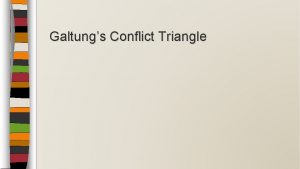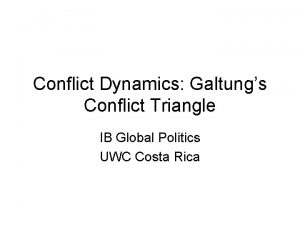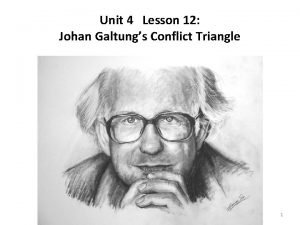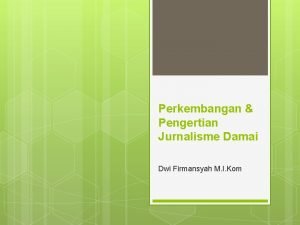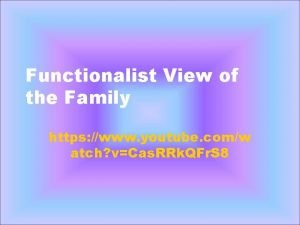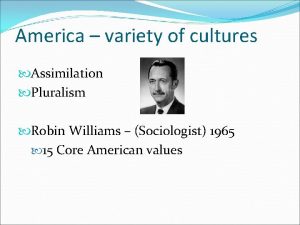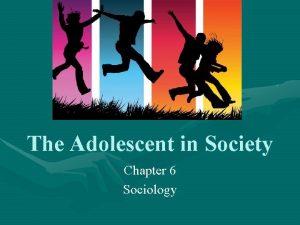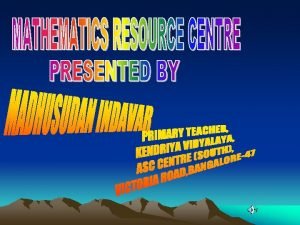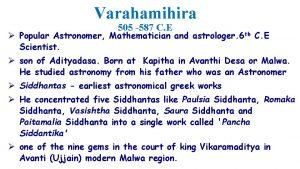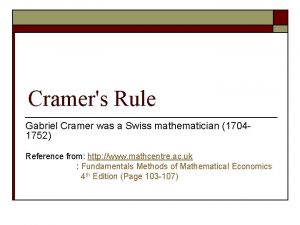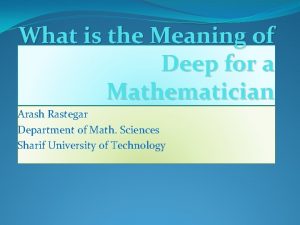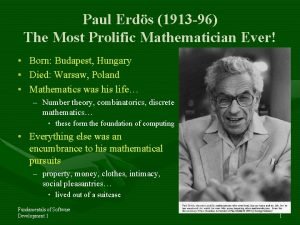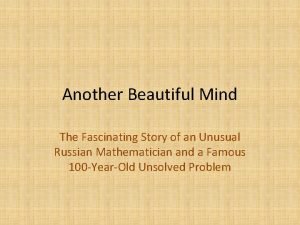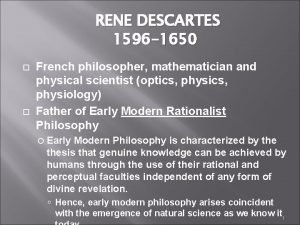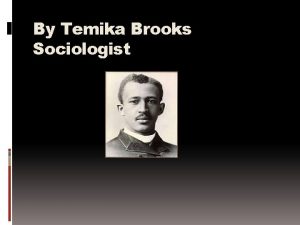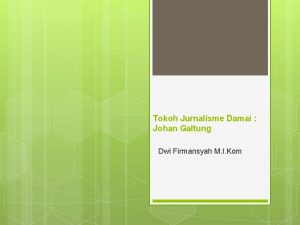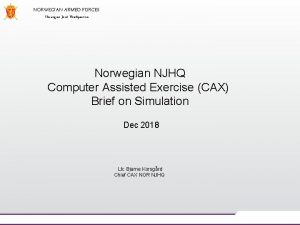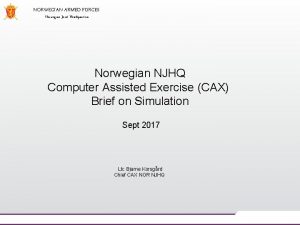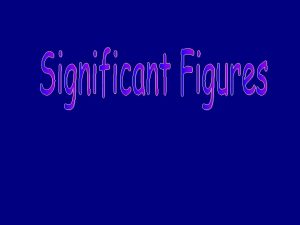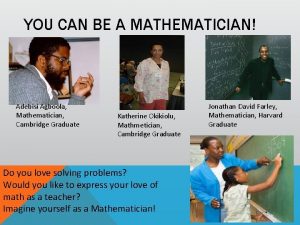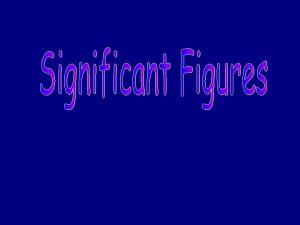Galtungs Conflict Triangle Johan Galtung Norwegian sociologist mathematician

















- Slides: 17

Galtung’s Conflict Triangle

Johan Galtung �Norwegian sociologist, mathematician, helped found discipline of peace & conflict studies �Lots of theories…. Works on positive vs. negative peace; structural violence; conflict & conflict resolution; peacebuilding; imperialism; USA as republic & empire �Often critical of W. countries & attitude toward Global South

Conflict & Violence �Conflict can be negative but also POSITIVE. �Conflict does NOT equal violence, but violence is one possible response to specific conflict �Possible to identify specific causes & more general conditions that make violent conflict more likely

ABC Triangle �Framework to analyze stakeholders/ actors �Attitudes �Behavior �Context/ Contradictions

Manifest Level: How people act encourages conflict, immediate evidence of conflict Behavior Violence, genocide, insurgency attacks, discriminatory acts Behavior has roots in peoples’ attitudes & politicaleconomic context Latent Level; How people think encourages conflict; deeper causes of conflict Attitudes: Racism, discriminatory attitudes, sexism, victimhood, trauma Context/ Contradictions Inequality, dispute over territory or resources

Context & Contradiction �Incompatibility of goals/ needs/ interests btwn parties �Social structure / values? (patriarchy? Caste? Ethnicity? Rich-poor? ) �Scarcity? (of anything- water, oil, elected officials? ) �Competition? (in elections? For power? For market share? ) �Migration? (rural to urban? N. Africa to Europe? ) �Change? (social, political, economic, globalization, climate, etc)

Attitudes �Psychological conditions �Cognitive (perception, enemy construction, negative stereotypes, etc); feelings (hate, anger, suspicion, etc)

Behavior �Polarizing & often destructive activities of parties (actual visible behaviors) �Throwing, burning, killing, shooting, rioting, demonstrations, war, etc.

Conditions making violent conflict more likely: Conditions making violent conflict less likely: • Little or no democratic means of • Democratic institutions exist, with full dispute resolution; minorities excluded political equality and participation from political representation • Equal sharing of resources and • Wealth, territory or resources shared wealth unequally and controlled by powerful elites • Equality of opportunity for all • Poverty • Government respects the rule of law • Government is above the law, making • Disputes can be resolved fairly arbitrary and illegitimate decisions through a fair and independent judicial system • Judicial system is absent or interfered with, not independent or fair • Respect for human rights (especially of minorities) • Human rights are abused

http: //tilz. tearfund. org/en/resources/publications/footsteps/footsteps_91 -100/footsteps_92/abc_of_conflict_analysis/

�Sometimes violent conflict is shallow- the roots of the violence are not deep (maybe a misunderstanding? ) �Sometimes, there may be little violent behavior, but there are deep-rooted problems in people’s attitudes and the context. ◦ Latent conflict: must address the roots of conflict before they lead to actual violence �The most difficult kind of conflict is persistent conflict, in which violence is both visible and deep-rooted. � http: //tilz. tearfund. org/en/resources/publications/footsteps_91 -100/footsteps_92/abc_of_conflict_analysis/

Conflict Triangle Example: Syria

Behavior Violence, genocide, insurgency attacks, discriminatory acts Manifest Level: How people act encourages conflict, immediate evidence of conflict Latent Level; How people think encourages conflict; deeper causes of conflict Attitudes: Racism, discriminatory attitudes, sexism, victimhood, trauma Galtung’s Triangle: Syria Context/ Contradictions Sunni majority is in in conflict with President’s Alawite sect, which has drawn in Sunni and Shia regional powers. Sunnis feel marginalized by Assad’s Shia-led gov’t; Islamic State (ISIS) believes it is right to create Sunni Muslim caliphate across Syria and Iraq – does not accept current int’l borders Taken from Murphy and Gleek (2016)

Behavior Violence, genocide, insurgency attacks, discriminatory acts Manifest Level: How people act encourages conflict, immediate evidence of conflict Galtung’s Triangle: Syria Latent Level; How people think encourages conflict; deeper causes of conflict Attitudes/Assumptions: Assad gov’t believes it should stay in power & that rebel forces are ‘terrorists’ challenging legitimate authority of the state. Sunni rebels feel Assad gov’t not legitimate, demanding greater representation and political equality; Sunnis marginalized by Assad-led Shia government Context/ Contradictions Sunni majority is in in conflict with President’s Alawite sect, which has drawn in Sunni and Shia regional powers. Sunnis feel marginalized by Assad’s Shia-led gov’t; Islamic State (ISIS) believes it is right to create Sunni Muslim caliphate across Syria and Iraq – does not accept current int’l borders Taken from Murphy and Gleek (2016)

Behavior Assad gov’t: military campaign vs. insurgency, chem weapon attacks (Aug 2013) Sunni rebel forces: violent insurgency Manifest Level: How people act campaign to est Sunni Islamic ISIS: military encourages conflict, immediate evidence of everyone caliphate; fighting Conflict Triangle: Syria conflict & others! Latent Level; How people think encourages conflict; deeper causes of conflict Attitudes/Assumptions: Assad gov’t believes it should stay in power & that rebel forces are ‘terrorists’ challenging legitimate authority of the state. Sunni rebels feel Assad gov’t not legitimate, demanding greater representation and political equality; Sunnis marginalized by Assad-led Shia government Context/ Contradictions Sunni majority is in in conflict with President’s Alawite sect, which has drawn in Sunni and Shia regional powers. Sunnis feel marginalized by Assad’s Shia-led gov’t; Islamic State (ISIS) believes it is right to create Sunni Muslim caliphate across Syria and Iraq – does not accept current int’l borders Taken from Murphy and Gleek (2016)

Your Turn! �Working with a partner (maybe a group of 3), you will choose a conflict (some we’ve studied, some we haven’t) and do some background research on these elements of the triangle- attitudes, context, and manifest behaviors �Next class you will present your conflict triangle to the class [verbal presentation, but create a visual triangle to help encourage focus while you speak] �Try to incorporate a few different perspectives for each element �Grade will be participation + presentation together.

Conflicts �Somalia (civil war, 1990 s-) �Kashmir (India-Pakistan) �Darfur �Colombia (1960 s-) �Yemen (civil war, 2015 -) �Kurdish-Turkish (1948 -) �Boko Haram (Nigeria) �Libya (2011 - or 2014 -) �South Sudan (2013 -) �Central African Republic (2012 -)
 Johan galtung conflict triangle
Johan galtung conflict triangle Galtung's triangle
Galtung's triangle Galtung’s conflict triangle
Galtung’s conflict triangle Karakteristik jurnalisme damai
Karakteristik jurnalisme damai Murdock 4 functions of family
Murdock 4 functions of family Robin williams core american values
Robin williams core american values Edward thorndike
Edward thorndike Adolescence sociology definition
Adolescence sociology definition Famous mathematicians and their contributions
Famous mathematicians and their contributions Sant varahamihira
Sant varahamihira Cramer’s rule was discovered by swiss mathematician
Cramer’s rule was discovered by swiss mathematician Polish mathematician stefan
Polish mathematician stefan Venkat subramaniam mathematician
Venkat subramaniam mathematician Italian physicist mathematician astronomer and philosopher
Italian physicist mathematician astronomer and philosopher Mathematician meaning
Mathematician meaning Erdos number calculator
Erdos number calculator Poincare conjecture solution
Poincare conjecture solution French philosopher mathematician
French philosopher mathematician
